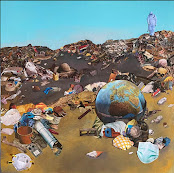emiliewouters_DESMA9
(U1) A Look Into Two Cultures- Literary Humanities and Science
 |
| Depiction of the choice between the cultures |
As someone who has hopped between the two sides of literature and science her whole life, I can see many connections and disparities between these two cultures. From a young age, this idea of being a “science person” vs being a “humanities person” is drilled into us, and leads us to believe that we must be one or the other. Early on, we sort of decide that we belong to one of the two cultures, and we base our futures and our studies around this idea. Those of us that enjoy both then choose one and neglect our passions and talents that could be helpful in the other. The spread of a third culture as described by Kevin Kelly in his article “The Third Culture” and Victoria Vesna in her article, “Toward a Third Culture: Being In Between” could be useful in bridging the gap between literature and science. As C.P. Snow suggested in the second edition of his book, a third culture would do just that. The separation of cultures is even seen in UCLA with "north campus vs south campus". The arts and humanities vs the STEM majors. There is rarely any crossover.
 ⇾
⇾ 
Depiction of the term STEM Depiction of the term STEAM
In my experience, growing up in the push for women to break into “STEM”, science seemed to be held in a higher regard than literature. Narratives such as “if you’re smart, you do STEM”, or “if you can do STEM, it is better for everyone that you make a career of it, it’d be a shame to waste such a good scientific mind on the arts” got strongly pushed. Meanwhile, the scientific field is entirely unwelcoming to women. Recently, the term “STEAM” has cropped up, indicating a shift toward a third culture, or at least more communication between the two existing ones. When first I saw that acronym, it made me feel like maybe I didn’t have to neglect one side of me, one of the cultures, and I could use elements of each culture to make greater advances than I would make if I kept the two cultures divided. I even chose a major that is interdisciplinary, so that I can try to use my skills in both cultures. In the future, I may attempt to take it a step further with a minor in the arts, as my major leans toward STEM and I seek balance.
References
Snow, C.P. The Two Cultures: And a Second Look. N.p.: n.p., 1963. Print.
Vesna, Victoria. "Toward a Third Culture: Being In Between." Leonardo. 34 (2001): 121-125. Print.
Kelly, Kevin. "The Third Culture." The Third Culture. N.p., n.d. Web. Feb. 1998
Depiction of the Term STEAM. n.d., patch.com/img/cal/sites/default/files/users/109677/20190312144006/steam_image.png. Digital Image.
Depiction of the Term STEM. n.d., strictlybriks.com/product_images/uploaded_images/make-stem-learning.jpg. Accessed 2021. Digital Image.
Man Standing at a Crossroads Sign with Various Subject Options. 2014, nemisha8.files.wordpress.com/2014/06/6a012876c6c7fb970c01676913b1fd970b-500wi.jpg. Digital Image
Hi Emily, I greatly enjoyed reading your blog post this week as a lot of its sentiments resonated with me as well. I think your description of the shift from STEM to STEAM was a great real-life example of the "third culture" we discussed in class. The term STEM—a term praised and pushed onto students all too often in the past ≈ decade or so—inherently places emphasis on the "two culture" system, the separation between the arts and sciences. The term STEAM, therefore, looks past the past separation between these two cultures and embraces the interdisciplinary beauty of education that we will learn about more in this class. By including Arts with Science, Technology, Engineering, and Math, STEAM upends society's emphasis on a STEM education. I hope to see the term STEAM advertised more frequently and especially during elementary education. It is important for students to recognize the interconnectedness of these two cultures from a young age. In this way, both cultures can be enhanced and strengthened as one is not preferred over another by society. What are some more real-life examples of this Third-Culture shift described by Kevin King and Professor Vesna?
ReplyDelete